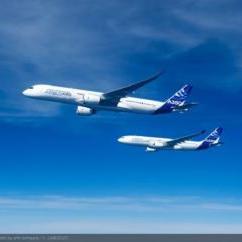
According to Airbus’ latest Global Market Forecast (GMF), Latin American and Caribbean airlines will require 2,294 new passenger and freighter aircraft between 2014 and 2033, including 1,784 single-aisle, 481 twin-aisle and 29 very large aircraft (VLA) worth an estimated US$292 billion. Globally, by 2033 some 31,358 new passenger and freighter aircraft valued at nearly US$4.6 trillion will be required to satisfy future robust market demand.
Latin America and the Caribbean has become one of the most urbanized regions in the world. The region’s GDP is currently growing at 3.9 percent per year, a growth rate above the world average of 3.2 percent per year. In the next 10 years, the economy in Latin America and the Caribbean is expected to outperform the world average, while the middle class population is forecast to grow more than 40 percent by 2033, from 278 million to 398 million people.
A strong economy and growing middle class has set the stage for the region’s traffic to grow at an average of 4.9 percent annually in the next 20 years, outperforming the world average of 4.7 percent. As a result, traffic flows within Brazil, between the United States and South America and between Western Europe and South America will grow to be among the top 20 in the world by 2033.
Moreover, while nearly all of the 20 largest cities in North America and Europe connect passengers with at least one flight per day, only 40 percent of Latin America’s top 20 cities do so. Today, North Americans and Europeans are the most willing to fly, taking 1.6 and 1.0 trips per capita, respectively, but in the next 20 years, Latin America and Caribbean travelers will travel twice as much to reach the levels in Europe today. As a result, intra-regional and domestic traffic within Latin America and the Caribbean is expected to triple by 2033, growing at an impressive rate of 5.6 percent and becoming the biggest market for Latin American carriers.
"In regards to long-haul market, while the top European and North American airlines carry nearly 40 percent of the traffic, the top airlines of Latin American and the Caribbean only carry 19 percent, foregoing valuable revenue to foreign competitors," said Rafael Alonso, President of Airbus for Latin American and the Caribbean. “This year, we are finally seeing Latin America carriers reposition themselves to capture international traffic, but huge potential remains for regional airlines to increase their market share on long-haul routes.”
"We are also seeing an increase in the region’s average aircraft size, a trend that validates our innovation investments to develop aircraft such as the A321 and the A350 XWB,” continued Alonso. “The A350‘s size, high efficiency and extra wide cabin will certainly help the region's airlines capture lost long-haul traffic."
Precisely the region’s impressive traffic growth is fueling the expansion and success of the region’s low cost carriers (LCC). While most LCC traffic is currently concentrated in Brazil and Mexico, existing and future intra-regional and domestic traffic demand is already driving further LCC growth in Colombia and other markets throughout the region.
The GMF also shows that Latin American airlines continue to invest in new aircraft to maintain one of the youngest and most efficient fleets in the world. With a current average aircraft age of 9.5 years, aircraft operating in Latin America are 40 percent younger today than they were in 2000. On the other hand, the average aircraft age in the Caribbean remains at 15 years - - more than five years older than the Latin America and world average.
With more than 800 aircraft sold and a backlog of almost 400, over 550 Airbus aircraft are in operation throughout Latin America and the Caribbean. In the last 10 years, Airbus has tripled its in-service fleet, while delivering more than 60 percent of all aircraft operating in the region.
- Login to post comments


Recent comments
9 years 12 weeks ago
9 years 32 weeks ago
9 years 36 weeks ago
9 years 39 weeks ago
9 years 40 weeks ago
12 years 7 weeks ago
12 years 21 weeks ago
12 years 41 weeks ago